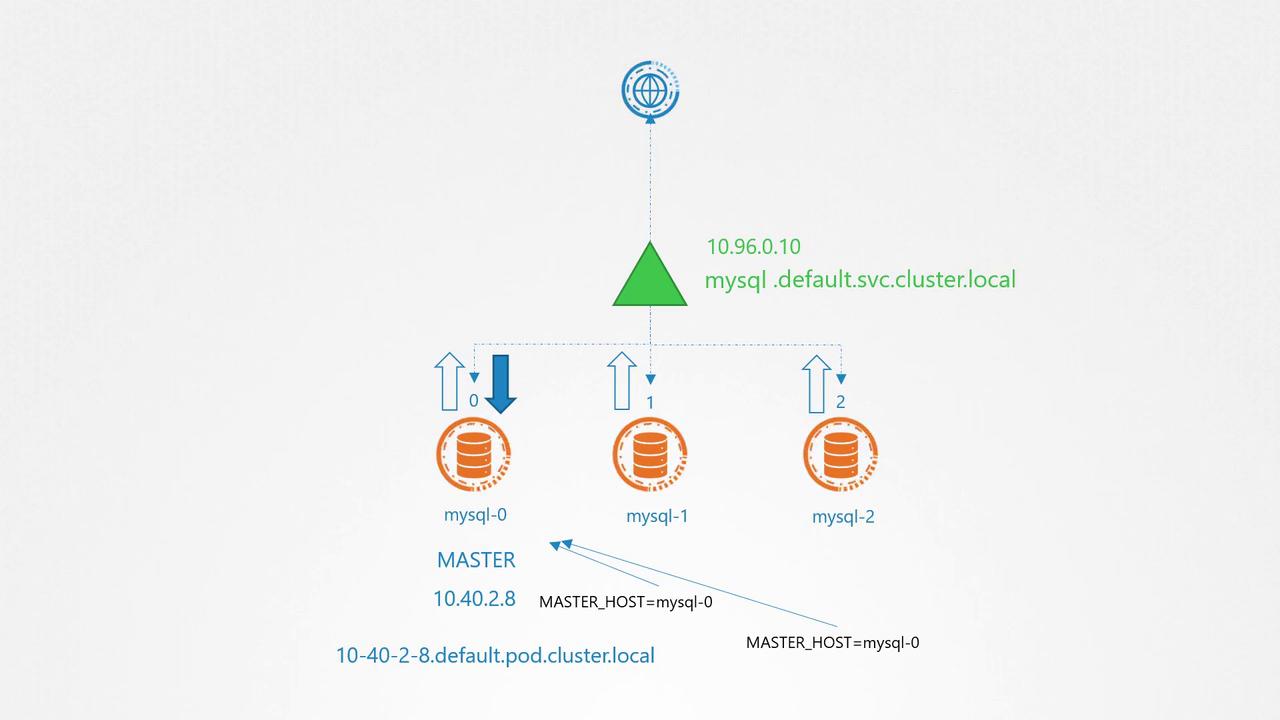Certified Kubernetes Application Developer - CKAD
State Persistence
Headless Services
In this article, we explore headless services in Kubernetes and how they solve routing challenges in a master-slave architecture, such as a MySQL cluster. When using a StatefulSet, each pod is deployed one at a time with a unique ordinal index (for example, mysql-0, mysql-1, mysql-2). This approach provides stable, unique names for each pod, making it easier to direct connections to specific nodes—an essential requirement for database clusters where write operations must be handled by a single master.
The Problem with Traditional Services
Under typical conditions, Kubernetes services function as load balancers. They provide a Cluster IP and a DNS name (like mysql.default.svc.cluster.local) that routes traffic evenly to all matching pods. This behavior is acceptable when the application only performs read operations in a MySQL cluster but becomes problematic for write operations. Write queries must be directed solely to the master pod, and load balancing across all pods could lead to data inconsistency or conflicts.
How Headless Services Address the Issue
Headless services eliminate the load balancing behavior by not assigning a Cluster IP. Instead, they generate DNS records for each individual pod in the following format:
pod-name.headless-service-name.namespace.svc.cluster.local
For example, if you create a headless service named "mysql-h", the master pod can be accessed via:
mysql-0.mysql-h.default.svc.cluster.local
This DNS entry consistently resolves to the master pod in the MySQL deployment.
Note
In a headless service, setting clusterIP to "None" is the only key difference from a standard service definition.
Headless Service Definition Example
Below is an example of how to define a headless service:
apiVersion: v1
kind: Service
metadata:
name: mysql-h
spec:
ports:
- port: 3306
selector:
app: mysql
clusterIP: None
Configuring Pods to Use Headless Services
When deploying a pod under a headless service, include the optional fields subdomain and hostname in the pod specification. The subdomain must match the name of your headless service, ensuring that Kubernetes creates the correct DNS record.
For example, to create a pod with only the subdomain specified:
apiVersion: v1
kind: Pod
metadata:
name: myapp-pod
labels:
app: mysql
spec:
containers:
- name: mysql
image: mysql
subdomain: mysql-h
However, to generate a fully qualified DNS record that includes the pod name, you must set the hostname field as well:
apiVersion: v1
kind: Pod
metadata:
name: myapp-pod
labels:
app: mysql
spec:
containers:
- name: mysql
image: mysql
subdomain: mysql-h
hostname: mysql-pod
Visual Overview of a MySQL Cluster Setup
The diagram below illustrates the setup of a MySQL database cluster with one master and two replicas. It highlights the network configuration, including IP addresses and hostnames:

Deployments vs. StatefulSets
When deploying pods using a Deployment, the pod template generally does not specify the hostname or subdomain fields. Consequently, the headless service is unable to create unique A records for each pod. If these fields are manually added to the pod template, every pod receives the same DNS record, resulting in an address like mysql-pod.mysql-h.default.svc.cluster.local, which is unsuitable for distinct addressing.
Deployment Example with Identical DNS Records
Below is an example where a Deployment assigns the same hostname and subdomain to all pods:
apiVersion: v1
kind: Service
metadata:
name: mysql-h
spec:
ports:
- port: 3306
selector:
app: mysql
clusterIP: None
apiVersion: apps/v1
kind: Deployment
metadata:
name: mysql-deployment
labels:
app: mysql
spec:
replicas: 3
selector:
matchLabels:
app: mysql
template:
metadata:
labels:
app: mysql
spec:
containers:
- name: mysql
image: mysql
subdomain: mysql-h
hostname: mysql-pod
In this configuration, all pods share the same DNS record because they have identical hostnames and subdomains.
Leveraging StatefulSets for Unique DNS Records
StatefulSets are designed to overcome this limitation by automatically generating unique hostnames for each pod. You do this by simply referencing the headless service name in the StatefulSet specification using the serviceName field. Kubernetes then assigns a unique DNS record to each pod based on its ordinal index.
StatefulSet Example with Headless Service
Below is an example of a StatefulSet that utilizes a headless service:
apiVersion: v1
kind: Service
metadata:
name: mysql-h
spec:
ports:
- port: 3306
selector:
app: mysql
clusterIP: None
apiVersion: apps/v1
kind: StatefulSet
metadata:
name: mysql-deployment
labels:
app: mysql
spec:
serviceName: mysql-h
replicas: 3
selector:
matchLabels:
app: mysql
template:
metadata:
labels:
app: mysql
spec:
containers:
- name: mysql
image: mysql
In this configuration, each pod is assigned a unique DNS record, for example:
mysql-0.mysql-h.default.svc.cluster.local
mysql-1.mysql-h.default.svc.cluster.local
mysql-2.mysql-h.default.svc.cluster.local
This setup meets the requirement for distinct addressing, ensuring that write requests intended for the master pod are routed correctly.
Key Takeaway
StatefulSets combined with headless services provide a robust solution for applications requiring individual pod addressing without load balancing interference.
Watch Video
Watch video content